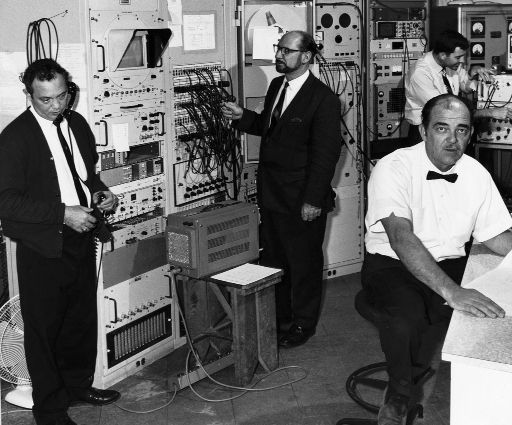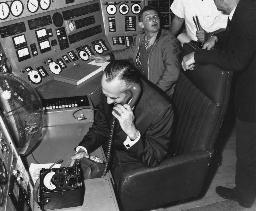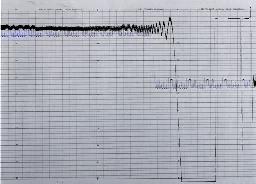
Photo CSIRO: NASA personnel at Parkes (L-R) Alfred Stella, George Kropp, William Reytar (back) and Robert Taylor (seated at front). Click on the image to see their biographies.
Pre-launch:
On Tuesday, 13 May 1969, the Minister of Supply, Senator Ken Anderson, and the Minister for Education and Science, Mr Malcolm Fraser, released a joint statement in Canberra announcing the Parkes Observatory's involvement in the Apollo 11 mission.
From 9 to 12 June 1969, AWA technicians arrived at the Observatory to begin installing the microwave equipment on the east-west service tower. They then returned on 1 July to continue the installation and testing of the equipment, staying until the end of the mission. At the same time PMG technicians, working under the Divisional Engineer, Mr W. Nankivell, began installing the communications network using existing telephone circuits between the telescope and the Beargamil and Alectown exchanges.
On 23 June 1969, a four-man team of NASA engineers arrived in Parkes to install the Unified S-band front-end receiving and monitoring equipment. The equipment suffered a few breakages during transport from the US, but these were repaired shortly after arriving at Parkes. The team was led by the Operations Manager, Mr Robert Taylor. The other three engineers were Mr Alfred Stella, Mr George Kropp, and Mr William Reytar. Their task was to receive, record and relay the full set of voice, television, telemetry, and biomedical signals to Houston. Also during this period Richard Holl, from the OTC Paddington terminal, made three visits to the observatory to install the TV equipment.
 Photo CSIRO: NASA personnel at Parkes (L-R) Alfred Stella, George Kropp, William Reytar (back) and Robert Taylor (seated at front). Click on the image to see their biographies. |
According to Jasper Wall, a young PhD student at Parkes at the time:
Photo CSIRO: The Parkes telescope tracking the Moon during a test several weeks before the mission. |
Telescope pointing during the mission was to be supplied by NASA a few hours ahead of time by lists of equatorial and altazimuth coordinates as a function of time. These were sent using teletype machines. In order to test emergency procedures such as visual guiding on the Moon from the hub room, and manual drive from the altazimuth gearboxes, trial sets of computations for the landing were requested from NASA by John Bolton. These were sent back, for the sets neither agreed with each other nor with the position of the Moon. A second lot had the equatorial and altaz coordinates agreeing but not the Moon. A third attempt was based on Parkes being located at 33o latitude north rather than south. Eventually, a correct set of coordinates was received, and on 1 July a Moon pointing test was successfully conducted with the S-band (13 cm) NASA receivers.
Again Jasper Wall relates:
On 14 July an exhaustive 10-hour test was carried out on tracking, recording and relaying operations. These operations were shown to the visiting press contingent. On the day before launch, 16 July, a pointing accuracy check was performed as well as sensitivity checks of the two feed and receiver systems.
The Press arrives:
 Photo CSIRO: Mr. Willson Hunter (on Phone) and John Bolton (seated back) during the press conference. Click on the image to see more pictures and movies of the press conference. |
During the press conference the ABC reporter, Tom McKay, asked John Bolton what the chances were of a technical breakdown during the mission. In a stunningly prophetic reply, John answered:
Access to site restricted:
For a period of five days, from 17 to 21 July, the Observatory, Visitors' Centre, and all access roads for several kilometres from the telescope were closed to the general public. This was to prevent any outside interference from cars and other devices from disrupting the signal reception. Federal Police officers secured the site, and to gain access staff members were issued keys with "A 11" inscribed on a small aluminium key-tag.
Cruise to the Moon:
The tracks to the Moon were to test the tracking operations at Parkes, and to ensure that all the receiving equipment and relays functioned as planned. The responsibility of John Bolton, the Director of the Observatory, was to ensure that the telescope followed a precise tracking programme, and that all of the telescope's functions performed flawlessly.
The tracking data provided by NASA was in the form of a list with the predicted positions of Apollo 11 given in four-minute intervals. The telescope operator (known as the driver) would point the dish at the first predicted position. He would then move the dish in both axes at the correct rates so that four minutes later the dish would arrive at the next predicted position on the list. Often however, if the dish wasn't on position at the assigned time, the driver would have to move the dish quickly in order to catch up. Also, the driver could monitor the track on the signal strength indicator, and if required, move the dish to maximise the signal strength received. The drivers during the cruise to the Moon were Neil Mason, Bill Butler, and Ben Lam.
The journey to the Moon was uneventful, apart from errors of up to 25 arcmin in the NASA pointing data. On the day of the launch, 17 July, a pointing check was performed before the spacecraft was acquired some 13.6 hours after launch at 3:00 p.m. (AEST). The logbook entry indicates that a search for the spacecraft was required for an hour before it was picked up. There is no indication why this was so, but it may have been an error in the NASA pointing data. The tracks to the Moon were intended to provide back-up to the Deep Space Tracking Network (DSN). This overlap with the DSN may be why the provision of accurate pointing data was so lax. NASA's main concern for Parkes was the lunar EVA, and pointing data for that was accurate.
For the next two days the telescope continued to track Apollo 11 flawlessly to the Moon. Mrs Letty Bolton would visit the operators, delivering them sandwiches packed in a picnic basket.
One interesting observation made at this time, was the variation in signal strength as the spacecraft performed its passive thermal control roll, or barbecue roll. This involved the spacecraft slowly spinning around its long axis, like a barbecue spit, in order to stabilise its thermal response to solar heating, that is, to prevent one side from overheating and the other from freezing. This slow spinning motion showed up as a slow, rhythmic variation of signal strength as the antennas on the command module, Columbia, rotated with the spacecraft. The period of the variations in signal strength was exactly the period of the thermal control roll.
 Photo CSIRO: The CSM occultation observations by Cooke and Wall. |
Jasper Wall relates the following:
All the spacecraft and telescope systems were fully checked and were now ready for the great day.